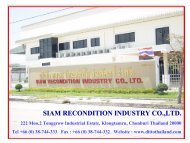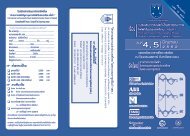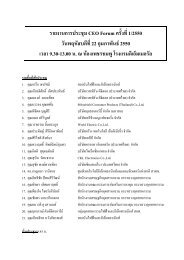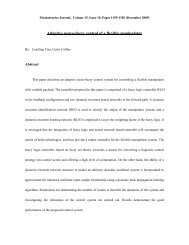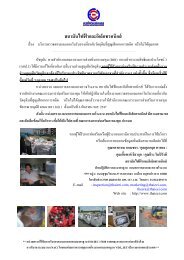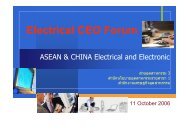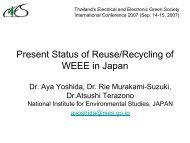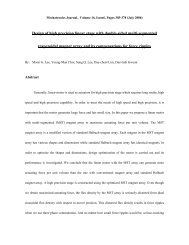Environmental and Energy Management in a Textile Dyeing ... - IGES
Environmental and Energy Management in a Textile Dyeing ... - IGES
Environmental and Energy Management in a Textile Dyeing ... - IGES
Create successful ePaper yourself
Turn your PDF publications into a flip-book with our unique Google optimized e-Paper software.
Self-regulation<br />
The need for improvement <strong>in</strong> audit<strong>in</strong>g <strong>and</strong> benchmark<strong>in</strong>g<br />
The pr<strong>in</strong>cipal motivation for the company to develop cleaner production methods is the<br />
reduction of costs associated with <strong>in</strong>efficiencies with<strong>in</strong> their operation. Upper<br />
management was able to reduce these costs through energy audit<strong>in</strong>g <strong>and</strong> benchmark<strong>in</strong>g.<br />
These are effective tools for an organisation to monitor the actual performance of their<br />
company, to recognize <strong>in</strong>efficiencies, discover where there is room for improvement, <strong>and</strong><br />
f<strong>in</strong>ally be able to improve performance.<br />
Technologies<br />
Installation of automatic equipment to improve efficiency<br />
Retrofit of the boiler system played an important role <strong>in</strong> improv<strong>in</strong>g the energy efficiency<br />
of the factory, elim<strong>in</strong>at<strong>in</strong>g steam release, <strong>and</strong> improv<strong>in</strong>g efficiency of their equipment.<br />
The improved technology provided a great opportunity for the factory to reduce heat loss<br />
due to the release of steam <strong>and</strong> the accumulation of condensate <strong>in</strong> the pip<strong>in</strong>g system.<br />
Moreover, <strong>in</strong> the colour-match<strong>in</strong>g processes, a computerised colour-match<strong>in</strong>g device was<br />
<strong>in</strong>stalled to enhance speed <strong>and</strong> accuracy, result<strong>in</strong>g <strong>in</strong> fewer defects <strong>and</strong> <strong>in</strong>creased<br />
customer satisfaction. Introduction of these new technologies assisted the company <strong>in</strong><br />
improv<strong>in</strong>g its performance.<br />
Impacts<br />
• The company developed an environmental <strong>and</strong> energy management system as a<br />
management tool <strong>and</strong> a fundamental framework for the company to move toward better<br />
production efficiency. They can thus recognise problems <strong>and</strong> <strong>in</strong>efficiencies, <strong>and</strong><br />
subsequently, they set up a cont<strong>in</strong>u<strong>in</strong>g improvement program.<br />
• Implementation of cleaner technology resulted <strong>in</strong> cost reductions. For example, the boiler<br />
<strong>and</strong> steam trap retrofit led to a 20 percent reduction <strong>in</strong> fuel oil consumption.<br />
• Cleaner technology practices also help <strong>in</strong> <strong>in</strong>creas<strong>in</strong>g customer satisfaction due to better<br />
quality of product <strong>and</strong> services. For example, the colour-match<strong>in</strong>g process can now be<br />
completed with<strong>in</strong> two to three days, whereas it used to require ten to fifteen days.<br />
• Personnel <strong>in</strong>volved <strong>in</strong> establish<strong>in</strong>g environmental <strong>and</strong> energy management systems have<br />
consistently developed the knowledge <strong>and</strong> skills necessary for implementation of resource<br />
energy efficiency. In addition, operational staff have also developed better work<strong>in</strong>g<br />
procedures <strong>in</strong> order to elim<strong>in</strong>ate waste <strong>and</strong> reduce losses <strong>in</strong> the production process.<br />
• S<strong>in</strong>saenee Company can be used as a demonstration model for steam trap retrofit<br />
adaptations so that <strong>in</strong>terested parties <strong>in</strong> other factories could benefit by adopt<strong>in</strong>g this<br />
technology.<br />
Lessons Learned<br />
• A strong commitment from upper management is vitally important for improv<strong>in</strong>g<br />
efficiency <strong>in</strong> manufactur<strong>in</strong>g enterprises. In this case, the manag<strong>in</strong>g director played a key<br />
role <strong>in</strong> promot<strong>in</strong>g organisational changes, which then stimulated employees to actively<br />
participate <strong>in</strong> implementation.<br />
• An environmental <strong>and</strong> energy management system is an effective <strong>in</strong>strument for<br />
cont<strong>in</strong>u<strong>in</strong>g improvements, because it provides the basic tools for systematic monitor<strong>in</strong>g of<br />
performance.<br />
• Performance improvement is a cont<strong>in</strong>uous learn<strong>in</strong>g process <strong>in</strong> which returns from previous<br />
adaptations could be <strong>in</strong>centives that re<strong>in</strong>force further developments <strong>and</strong> better efficiency.<br />
• Improv<strong>in</strong>g environmental <strong>and</strong> energy performance can be seen as a means of <strong>in</strong>creas<strong>in</strong>g<br />
resource efficiency, lead<strong>in</strong>g to cost reductions <strong>and</strong> higher profits. Accord<strong>in</strong>gly, the<br />
4



